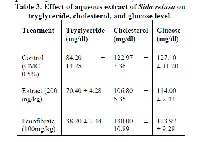Hypoglycemic and Hypolipidemic Effect of Sida rhombifolia ssp. retusa in Diabetic Induced Animals
Keywords:
Diabetes, Sida rhombifolia ssp, Retusa, hypoglycemic activity and hypolipidemic activityAbstract
In the present study, the anti-diabetic effect of aqueous extract of Sida rhombifolia ssp. retusa (Malvaceae) leaves was studied in normal and streptozotocin (STZ)-induced (60 mg/kg, single intraperitoneal injection) diabetic rats. Hypoglycemic activity in normal rats was tested after administration of 200 mg/kg of extract. Aqueous extract showed a 15% reduction in plasma glucose level after 1.5 h of extract administration. When tested in STZ-induced diabetic rats the reduction in plasma glucose was 17%. In oral glucose tolerance test in normal rats and STZ-induced rats the decrease in AUC was 15 and 7% respectively. Glibenclamide was used as reference drug and showed significant hypoglycemic effects in normal rats but had marginal activity in STZ-induced diabetic rats. In hypolipidemic study a dose of 200 mg/kg of aqueous extract has shown reduction in triglycerides (TG) (16%), cholesterol (4%), and glucose level (10%). Fenofibrate was used as standard drug for hypolipidemic study. The results obtained from the experiment provided scientific evidence in favor of the traditional use of Sida rhombifolia ssp. retusa leaves for the treatment of diabetes mellitus.
References
Alberti KG, Zimmet PZ. New diagnostic
criteria and classification of diabetes again.
Diabetic Med 1998, 15: 535-36.
Kim SH, Hyun SH, Choung SY. Antidiabetic effect of cinnamon extract on
blood glucose in db/db mice. J
Ethnopharmacol 2006, 104: 119-123.
Djrolo F, Houngbe H, Avode G, Addra B,
Kodjoh, N, Avinadje M, et al. Le diabète
lié à la mal nutrition (Diabète tropical).
Médecine Afrique Noire 1998, 45(8/9):
-542.
Nourparvar A, Bulotta A, Di Mario U,
Perfetti R. Novel strategies for the
pharmacological management of type 2
diabetes. Trends Pharmacol Sci 2004, 25:
-91.
Shaw KM. Overcoming the hurdles to
achieving glycaemic control.
Metab Clin Exp 2006, 55(1): 6-9.
Moller DE. New drug targets for type 2
diabetes and the metabolic syndrome.
Nature 2001, 414: 821-827.
Marles JR, Farnsworth NR. Antidiabetic
plants and their active constituents.
Phytomedicine 1995, 2(2): 123-129.
Luo Q, Cai Y, Yan J, Sun M, Corke H.
Hypoglycemic and hypolipidemic and
antioxidant activity of fruit extracts from
Lycium barbarum. Life Sci 2004, 76: 137-
Warrier PK. Indian medicinal plants:
Compendium of 500 species (vol. 5).
Orient Longman, Hyderabad, 1994, pp.
-137.
Valiathan MS. The Legacy of Caraka.
Indian Academy of Sciences, Orient
Longman, Delhi, India, 2003, pp. 431-432.
Dhalwal K, Shinde V, Mahadik KR,
Kadam SS. Hepatoprotective activity of
Sida rhombifolia ssp. retusa against
thioacetamide and allyl alcohol
intoxication in rats. Pharmacologyonline
, 3: 259-266.
Thangam J, Shanthakumari G. Central
nervous system effects of Sida retusa root.
Japan J Pharmacol 1971, 21: 136-138.
Sheth A. The herbs of Ayurveda (vol. 4).
Sheth A, Bhavnagar, Gujrat, 2006; p.
Szkudelski T. The mechanism of alloxan
and streptozotocin action in β-cells of the
rat pancreas. Physiol Res 2001, 50: 536-
Kamtchouing P, Sokeng DS, Moundipa
FP, Watcho P, Jatsa BH, Lontsi D.
Protective role of Anacardium occidentale
extract against streptozotocin-induced in
rats. J Ethnopharmacol 1998, 62: 55-59.
Cetto AA, Wiedenfeld H, Revilla MC,
Sergio I. Hypoglycemic effect of
Equisetum myriochaetum aerial parts on
streptozotocin diabetic rats. J
Ethnopharmacol 2000, 72: 129-133.



